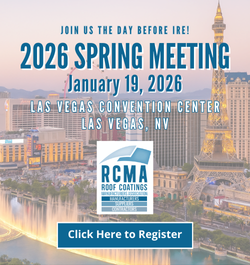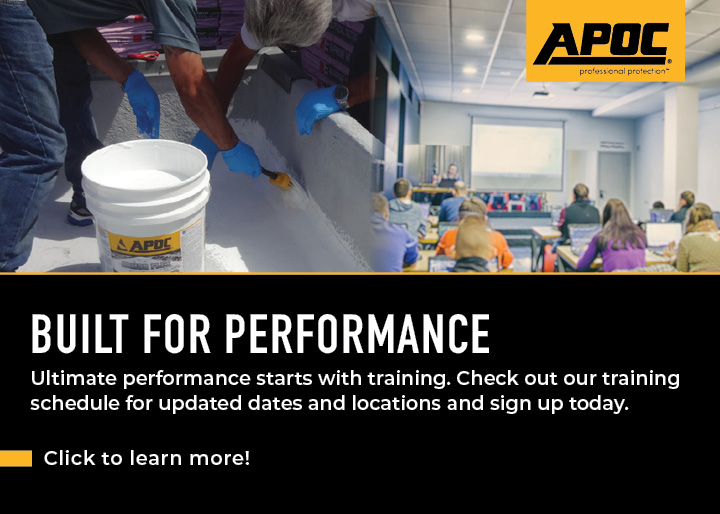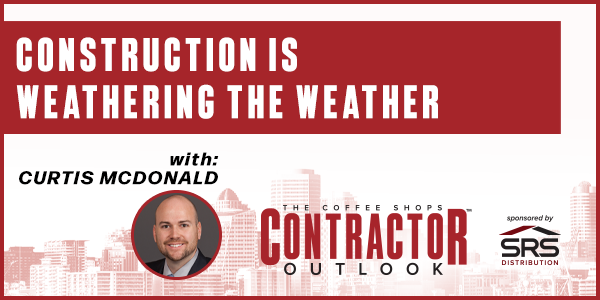UP TO THE MINUTE
Waterproofing Communication - PODCAST TRANSCRIPT
June 24, 2025 at 4:00 p.m.Editor's note: The following is the transcript of a live interview with Jan Bagnall from Pli-Dek. You can read the interview below, listen to the podcast or watch the recording.
Intro: Hello, everyone. My name is Megan Ellsworth, here at CoatingsCoffeeShop.com and you are watching a Lunch & Learn. I am here with Jan from Pli-Dek. Hello, how are you?
Jan Bagnall: Hello, Megan. It's wonderful to be here with you today.
Megan Ellsworth: Yay. I'm so excited. We're talking about waterproofing, communicating that to your customers and getting additional larger jobs through waterproofing systems. So before we jump in, let's start with you, Jan, just introducing yourself and a little bit about what you do at Pli-Dek.
Jan Bagnall: Well, I got into the decking business, I'm going to age myself here a little bit, back in 1979, did this system, Pli-Dek. And out in the market at the time were a lot of different systems that weren't working very well. A lot of them were urethane systems over plywood, which didn't seem to last very well, plus, they didn't meet the fire code. So I developed a new product that ended up going very viral and we went across the nation with it. The best thing about it was it was a fireproof product. It was early waterproofing. When you put the first coat, you're going to be waterproofing the first coat and then you can leave the job until such time as somebody else, all the other guys finish. You don't get stuck going to painters then come back. So nobody else was doing something like that and we just came in the market and everybody was looking for something like that. So now, if you look in California area in the West Coast, almost every deck that's on a wood frame assembly is a lathing-based system that I invented.
Megan Ellsworth: Wow. I can't believe you're here talking with us. That's awesome. Thank you so much for gleaning some of your wisdom on this Lunch & Learn today. I'm really excited to dive in.
Megan Ellsworth: So today, we have three learning objectives for the audience out there. The first one is understanding waterproofing systems. The second is educating your customers about waterproofing. And the third learning objective is communicating needs and those benefits to your customers. So Jan, let's dive into the first one, understanding waterproofing systems. Let's just start at the base. What are they made of?
Jan Bagnall: Well, there's a variety of different systems out there, but for the most part, this lathing-based system has taken over almost the United States. It's very, very popular on the West Coast and Florida as well. You'll find that our system has an expanded metal lathing, which is a steel mesh that goes down. It's a 2.5 pounds per square yard mesh, hot dip galvanized so it doesn't rust. Then we put a polymer cement in that, which is 6,000 psi. I mean, that's... the deck. So you can put chairs, tables, whatever you want. You're not really going to hurt a 6,000 psi. So it's like the same strength as your sidewalk in front of your house. It is flexible. It's about a quarter of an inch thick. That gets you through most of the fire ratings that you need to have, as long as you don't have combustible products on top of that.
Jan Bagnall: So here you have a waterproof system that goes down in construction that's durable as heck. You can put scaffolding on it and do all your stock coat and everything else, you're not going to really hurt it and you should be waterproof through construction with just the base coat. Now, you look at different, all the ASTM tests we had to take and a lot of them say, "Hey, I live in Colorado. There's snow on the deck. So it's not just about durability, it's about can you do a freeze-thaw cycle test or an accelerated aging test?" And the answer is yes. We've done 28 different ASTM tests on this product to make it last in the cold weather or the rainy weather or the inclement type stuff.
Jan Bagnall: So it's not just all about fire ratings, it's about longevity of the system and not breaking down in different environments. So we've done all that and being that we have all these non-combustible products on top, we can make it look like almost anything you want. So some guys want a hand texture or you could do a knockdown, you could do a sand finish or you could do smooth or you could do a pattern finish and you say, "Hey, I want my deck to look like tile or flagstone." That's an option as well. And any shades, any color that you want.
Megan Ellsworth: Cool. And what a selling point for contractors. That's cool that you can do anything.
Jan Bagnall: It wasn't planned this way. I started out as inventing a product for me and I was an applicator. In two years, I had 130 guys installing for me. But the architects got real excited about the product, so they kept specifying me and I didn't have enough guys to do all the jobs. So I started calling on other applicators and started training people and it got out of control. I mean, I went from California to Arizona to Nevada. Next thing you know I'm in Utah and New Mexico and Colorado, going that way and I just had to keep on training.
Jan Bagnall: And then I got out of the application business because I couldn't compete against the guys I was selling product to. So that company that I sold is still in business, is doing very, very well and my whole life now has been to train everybody across the nation and train my reps to train them across the nation, which is not how I started. I started with a hammer in my hand and a trowel in the other hand and I was mixing the stuff up and putting it down. And I did a lot... fun and next thing you know, I'm a manufacturer and I'm a teacher. I teach people. So that's what I do now.
Megan Ellsworth: Wow and I mean, you're just the perfect person to be doing this Lunch & Learn. Exactly, training people that can't get to you in person for a training, they're able to watch this. So what is this system made for? Just break it down. I know decks, outdoor walkways. Where do you see these systems?
Jan Bagnall: Well, balconies are number one you're going to... On commercial properties, you're going to have a lot of walkways because there's walkways on the second floor, maybe a third floor that are wood-framed. Perfect for that. You don't see a lot of balconies on commercial, but on residential, there's a ton of balconies and if you live by the coast, you're going to have balconies everywhere or up in the mountain you have balconies. So a lot of balconies, a lot of walkways, roof decks that you want to be... Let's say you want to go outside on your third-story house and you have a roof deck or even a commercial building that has a deck that people go out there and eat their lunch or they smoke or whatever else they do out there. But they want this deck that is walkable, that is basically a roof system [inaudible 00:06:17].
Jan Bagnall: In the ICC report they call it a walking roof deck. So it's in the roofing category, but it's basically something you can walk on, whereas you don't want to really walk on roofing products. So we make a very, very durable deck that you can sit down on and it can be waterproof. We also have, which after a certain amount of time, the architects were calling me up and says, "Jan, we need a sound-rated system. We got people going after us because someone's above them that's not living in their unit below and they can hear them walk and talk and everything else. So we need a sound-rated system." So Pli-Dek invented that as well and we're the only ones out there with a sound-rated decking system. So that was something I learned down the road that we had to get done because guys were getting litigation on sound control.
Jan Bagnall: So that came out as well. California, you had all these fires. So these fires came out and I'm sure you guys have seen them, that it was devastating out in Pacific Palisades. So it was really a high priority about fire ratings. So state fire marshal came out with something, not just a one hour and a Class A system and the Class A burns from the top side and the 1A burns from the bottom side of a deck. They [inaudible 00:07:24] fire zone test. So high fire zone test is something, all these high fire zone areas needed to have that. So Pli-Dek went out and got certified with that as well. We're the only one on their list right now that's certified, but I think one of the guys also have this finally. But that's important. I mean, almost all the architects out there want to see a fire-rated assembly.
Jan Bagnall: So what we do is we make sure... And roofers are ideal for this. And now you guys, one of your broadcasters is in a roofing coffee shop, perfect. I train roofing guys every single day. Ideal for roofing because now roofing guys, they're on the job, they got the roofs already and there's also walkways or decks on the job and contractors or developers want the same applicator a lot to do both things that are waterproofing on the roof and the waterproofing on the decks. So the roofers are ideal for learning this product to be versatile and doing other things, especially you probably get a little bit more money for decking. Because roofing gets very, very competitive. If you're putting down a roof and the guy down the street is a really good roofer as well and he's putting down a roof, you're putting down the same roof and it comes down to price a lot.
Jan Bagnall: You're going to say, "I'm bidding the same roof this guy's bidding, but we're going to put it down nicer and cleaner and faster." So you sell that part. But with the decking systems, there's so many different decking systems out there that you're not going apples and apples anymore. You're going apples and oranges. And so you are also, sometimes you're selling the decking system that you're installing that somebody else might be putting on something else that's maybe inferior that the builder looks at and says, "No, I'd rather buy the better deck that's going to make sure it's not going to leak." So in the decking systems, there's the variety like in every other trade out there, like electrical or plumbing. It's the same wires, it's the same pipes, but in decking systems it's different products that are out there with different approvals. So that's why Pli-Dek took off really big because we had all these approvals.
Megan Ellsworth: Yeah. And it's really an add-value for these contractors to add decking to their offerings and also to be using these approved products. It's such an add-value for their company.
Jan Bagnall: Let me comment on that. I've got a lot of friends now. I've been in this industry forever and I don't plan on retiring. I probably should, but I'm not going to because I have too many friends... I know. I know consultants and architects and all these builders out there. So I find that these guys and this happens almost every single time. Let's say they're a painter and they decided to be a decking guy too, so they get qualified to be a decking guy. Well, whatever they were selling a year in painting, all of a sudden they're selling more on the painting side. Or let's call it roofing, go back to roofing where most of your people are going to be listening are roofers. Let's say they do $4 million a year with the roofing. All of a sudden now they got decking systems that they're doing to add to what they do, their repertoire.
Jan Bagnall: Next thing you know, the roofing guy goes up to $6 million and the decking's $3 million. So almost every single time that I teach a new trade for someone, their existing trade they had benefits from that. They actually sell more product by being that versatile. So it's actually smart for guys to have that. Even if they don't want to go out and bid it every single time, they have it in their back pocket in case roofing goes slow and they have some decks, so they have a nice project with a walkway on it that they can do as well and make some more money. And so that's why it's important for these roofer guys just to have that option.
Megan Ellsworth: That's really interesting that you saw the original offering go up. That's really interesting. Yeah. Wow. Okay, so you kind of talked about the Class A fire rating. Let's talk about a little bit more of the capabilities of these decking systems, the durable surfaces, customizable, get more into the nitty-gritty.
Jan Bagnall: First of all, our system that we have, there's a lot of things that goes on in a plywood assembly. There's always deflection, the plywood deflects a little bit. But on the plywood seams, they actually shear when the building moves a little bit or they expand and they contract. So most of the conditions on the issues that are out there in the industry, when they do have an issue with other decking systems, the plywood seams are cracked, which you don't do so much on roofing because you have these single-ply roofs that span over that. But on decking systems, which bond basically to the plywood, you want to make sure you control those plywood seams. So what Pli-Dek has done is opened up those seams with the width of a saw blade and then we put a piece of paper down there before we put our lathing down and put the mud back down so the mud doesn't go back down in that seam and not give you any room for expansion/contraction.
Jan Bagnall: So that gives you more crack resistant from when you open up those seams to give you that movement control. In the middle of a sheet of plywood, you'll never see a failure. I mean, the middle sheet of plywood just does this. It bounces up and down a little bit for deflection, but those seams are really moving. So it's important to make your deck strong and make it available to expand and contract without buckling up. When the plywood seams get too close, it buckles up and next thing you know you got a crack. So we do that. We make sure those seams are done. We're the only ones that do do that, that make the plywood seams room for expansion and contraction.
Jan Bagnall: As a [inaudible 00:12:27], though, we have a fiberglass and resin and it's an acrylic resin. Our whole systems are acrylics with water-based acrylics, so you're not smelling any [inaudible 00:12:35] or anything. So that's user-friendly, so that's good. So you've got a 6,000-psi base coat. You come back, you put fiberglass and resin on it, which is almost like a piece of plastic. It's really strong and it's waterproof as well. And then unlimited textures. I mean, you could say, "I don't like this texture, I want that texture." So what our company does is we make samples for people. We turn them into the end user. They say, "We want this brown," and it might be 20 different browns out there that they could pick from. So if they don't pick from our chart, we ask them to pick from a standard chart from a big paint manufacturer, let's say Sherwin Williams or Dunn Edwards or Benjamin Moore or Behr paints. We have the formulations to make our product look like any color they pick from a color fan that has a thousand colors on it.
Jan Bagnall: So we give them the option of color. So what we do is we basically give them a sample that has the color and the texture that they want. So there's no mess-ups, so when they go to the job, the contractor knows he's not going to finish the job and someone comes up and says, "By the way, this is the wrong color and they're doing it all over again."
Jan Bagnall: Some of the other capabilities we have with our system, which is probably the most common of the things that we have to sort of help people through, is sloping. Most debt are sloped about a quarter of an inch per foot. We don't want to go over that. There's ADA and FHA requirements that the wheelchairs can't go past one quarter of an inch per foot, so we have to keep it under that. So we try to go somewhere between an eighth and a quarter, which we ask the framers to do, but a lot of times the framers don't get there.
Jan Bagnall: So we have to be able to slope our product. Well, we have a product that's called GU80 slope mix that I can put down as thick as I want and taper it down to zero in one application. So the builder says, "I've got truss joists. I can't slope them. I don't know what to do and he framed it flat, what do I do?" And I go, "Well, we can slope it as long as you have enough room at the threshold." I mean, if your threshold sits up an inch and a half and you need to go an inch to zero, it's no problem. We can slope that for them. So it's an option. Instead of them trying to go out there and rip out the plywood and re-slope the plywood we can actually do with our product.
Megan Ellsworth: That's great. And I mean, it's just sounding like it's a one-stop shop. You've thought of all the different solutions that these contractors need because you were the contractor.
Jan Bagnall: Well, you're making me age myself again. But yeah, I've been doing this for 46 years, Megan, so I can't say that I had everything figured out on day one, but we had a pretty good start, really good decking system. Along came a couple other things that we've done that makes it even better. But with our company, we've had no litigation in 46 years. We train everybody. So if your customers are out there, they're saying, "Well, this sounds like a good deal to me. I'm going to get trained to do Pli-Dek." We'll find a way to get you trained. We got guys across the country right now, not in every state, but if there's some states out there that we need to help out, we'll start maybe with a video online training and then have... out there to maybe do a job start for you the first time you do a job.
Jan Bagnall: But we don't like the guys going out there and putting a deck down that they saw a video or they saw maybe even an hour training and all of a sudden now they're supposedly experts. We can't have that. We're going to make sure that we carry these guys through a job start to make sure that's done right. So nobody's out there having a learning curve where, hey, the first three projects, we did fail, we didn't make any money, but now we'll start making money. We don't like that. We're going to try and make money on the first job.
Megan Ellsworth: Yeah, I love it. I love that. Okay, so we've made it to the second learning objective, which is educating customers about waterproofing. So how does adding deck systems to your business create more jobs and bigger contracts and how do the contractors add this into their business seamlessly?
Jan Bagnall: Number one, architects love us because architects have liability as well. Architects drop a set of plans and something's not right. Let's say it's not even a fire-rated deck and they put it down there and next thing you know they're getting in trouble and everybody's suing everybody because they didn't spec it right. When you go into an architectural presentation and you tell them of all the different tests that you've done and you've passed, it frees them of liability. The liability comes back [inaudible 00:16:42]. Your deck system better work because we're going to put it down exactly how you tell us to, which is the thing I've been hearing for 46 years, is "We're going to do exactly what you say, Jan." I go, "All right, I understand. I'm the guy in the hot seat." It works. So I have no problem doing that, but it does keep the consultants, the builders, the architects out of litigation as well.
Jan Bagnall: So these architects that are looking at it want to specify something that works. They want to specify something that has all the testing. They want to specify something that they can change something that they can't do with other decking systems, like if it's a little bit moist on the deck, we can put our product down. It's a water-based acrylic cement. It's just a little bit dew in the morning. Whereas a urethane can't do that. Urethanes can't do something like that or even they do have one system still out there that can't get moisture underneath this thing. It just marries in with our product. It's not an issue at all. So what happens out there is everybody wants to have something. And only a deck isn't the big, big cost item of building a project. The framers out there, the concrete guys out there and drywall and stucco is so big and you've got this little [inaudible 00:17:48].
Jan Bagnall: So if you look at all the different trades that are doing all these big bids, the decking part is probably the smaller part of what they would bid on building a project. So it's not really worth it to nickel and dime somebody out of doing something that's very, very important that they're going to get. I mean, if the deck leaks or a roof deck leaks, then you got mold and mildew when people are tearing up everything and they don't want to do that. That's the worst thing that could happen. So if there's another trade that something went wrong that you could fix real easy, hey, the stucco's got a bad texture to it or the concrete doesn't look that well, can you fix it? It doesn't do damage to the inside of your house, but when you're talking waterproofing, it's got to be done right.
Jan Bagnall: So people like to see something that's been tested as much as Pli-Dek has and has zero litigation issues for 46 years. Architects like that. That's why I think I grew so fast and I got out of control where I just had to... Every single day, Monday through Sunday, I'm training somebody, but I got... for many, many years it was me training. I didn't trust anybody else to say the wrong thing. So now I've got dozens and dozens of guys helping us out that everybody's learned this system now. So it's a lot better, but it is out there to protect not just Pli-Dek when we're selling something, we're protecting everybody that's involved to make sure that it's done right.
Megan Ellsworth: Exactly. No, I love that. It's protecting, like you said, the whole house from mold, mildew, keeping everything dry and safe and then the Class A fire rating is huge. Like you said, architects love that and especially in California. So let's talk about the decorative finishes. We already kind of talked about it a little bit, but how does that become indispensable for commercial customers where they can choose exactly what they want and make sure that it gets done, like you said in the beginning?
Jan Bagnall: When you get to the fancy finishes, which we do all the finishes, but I mean, most... out there are a knockdown. They spray a texture down, it looks like an orange peel, then they flatten it out. So it just has little textures to it. That's very [inaudible 00:19:51]. Some guys go a hand texture. They go, a hand texture's the easiest thing to do. They're about the same price. Even a sand finish, even a smooth finish, maybe the same price because it's the same amount of materials, same amount of labor.
Jan Bagnall: But when you get into a fancy finish, which you might get those on a really nice building or commercial building that has one community deck that they have for lunches and stuff and they want it to look like tile. Unlimited, so you could say you want a 12x12 or 16x16 or 20x20 or whatever you want. It can be created on that deck with different stencils or tapes that we can make, any single deck. Tiles could have different colors. This tile is black, this one's red, this one's white and you can make it that way or you can blend colors all in together. So it makes it look like a good tile, not just a ceramic tile, but a different kind of tile that has all the different colors and textures to it that's more expensive. So it's a more expensive look.
Jan Bagnall: When people normally see the tile for the first time, they mistake it for real tile. It looks like real tile and it's the waterproofing part. So the bad part about me being in this business where somebody calls me new and says, "We got this really nice tile over this wood assembly and it's leaking," and so I don't really know what's underneath that thing. I don't know whether it's dry rot, I don't know how the waterproofing is done, why it's failing. So more times than not, we tear the tile out and it's really sad for me to go to a new job and say, "You got to tear out all this thousands of dollars you spent for this tile." I got to get down to the root cause and make sure there's no dry rot. Get the waterproofing system fixed so you can put your tile back on.
Jan Bagnall: Or we could put a simulated tile system on top of that, which is serviceable, which you'll never tear off your deck again. So going to a warranty-type situation, Pli-Dek goes out there when you install the deck, according to specification with a certified applicator, it's a 10-year warranty. We do require a reseal in five years. Most people don't do that because the deck is holding up fine in five years, but we do like to see that. But when people call, let's say, one of our biggest customers is Irvine Company out here in California. Irvine Company is huge. They have hundreds of thousands of homes or apartments mostly, but they call us up in 10 years, say, "Jan, can you come out and service this deck and do a reseal," not me, but get my applicator to, "would you renew our warranty for an additional five years?" The answer 100% of the time has been yes.
Jan Bagnall: So you look at it and we have a 10-year warranty, but in 10 years it's renewable. You can come out and say, "Let me do some research, do some recoat on it, on just the colored sealer on the top, fix any little minor thing that's going on and we'll extend it for another five years." So it's renewable warranty. I could see it five plus five plus five plus five. If Irvine Company calls me up in 20 years and says the same thing, I'm going to give them another warranty, but by resealing it.
Jan Bagnall: So the deck system, it's a UV-stable product. It doesn't break down with UV rays... acrylic, where you'll see a lot of urethanes and you'll see a lot of latex that start decomposing and falling apart a little bit. The Pli-Dek system is 6,000 psi today as it will be in five years from now. It's not breaking down. It's not turning colors and decomposing either. So very, very durable, excellent UV ratings. And our biggest issue out there is nobody reseals it because it just lasts a long time. But once in a while, we had a guy that really wants to extend that warranty a bit longer and so we do get it resealed as well and we like to see that.
Megan Ellsworth: Yeah, that's huge. And I mean, that maintenance program has the customer, the contractor, coming back and really keeping that relationship strong with the building and building owner.
Jan Bagnall: Yeah, it's the last thing you want. A family buys a home and they get in there and they're all excited and everything's beautiful, they're so much in love with this new home. It's the start of their life and the first rain comes up and their walls are moldy and their carpet's all wiped out and they ruin their piano and they don't want that. So very, very important for these guys. These guys that take these classes, they look at YouTube on it and they figured out they know how to do a decking system. That's not really... It's the same thing with roofing. Roofing can, say, you can't just teach it sometimes. A lot of it's common sense, but there's a lot of things that are very, very important. So it is important to make sure you have a waterproofing assembly by the time you're done and I teach that. Listen, I said, "There's the cosmetic part of it that you guys can screw up a little bit and I'm okay with that."
Jan Bagnall: The homeowner, the end user's not. They're going to say, "Wait a minute, wait a minute. I don't know, this is too rough on my feet or you guys did a terrible job. You guys got to go back and fix it." But my intent is it's got to be waterproof. So when I teach that part, I go, "Okay, you guys, my job is to teach you how to waterproof this deck. It's not going to leak for years and years. It's going to be solid. Your job, after you do all my stuff I tell you to do, make it look good. I'll teach you how to do it, but if it looks bad, they're going to call me up and yell at me to yell at you." And I go, "I don't want to do that. So just make sure you do a good finish."
Jan Bagnall: So a little bit of a learned trade. I can get guys out there that probably spray knockdown better than I did. They do really good jobs, but most of the jobs I see are done pretty well. But there is once in a while I see a guy that does a half finish that they're going to have to go back and do a little bit of fixing, but that's not as important as this thing leaking. So that's a good call. Hey, the finish doesn't look good. Okay, [inaudible 00:25:04] says, "I got a leak," then they're not happy. So we don't get those calls. We try to stay on top of everything, but it's very important. There's going to be a lot of different, as roofers will see, there's a lot of different transitions. The weird transition into this door, into this other roof or into this deck and it just has to be flashed correctly.
Jan Bagnall: So what was very hard for me to teach is the sheet metal flashing and cover all the bases. You don't always cover all the bases. There's some standard flashing at a door, a wall, an outside edge, a post. You could get the standard stuff, but all of a sudden some other stuff comes into play. And now you have to start thinking, this is common sense, "How do I do this transaction so it transitions properly and doesn't leak behind that?" So when I look at rehab construction and we do a ton of rehab construction, I mean, a lot of it and when I do a job, I'm not looking in the middle of a balcony or a roof deck or a walkway. I'm not looking in the middle of the walkway. That's just plywood I'm going over. I'm looking at the perimeter, I'm looking at the doors and the walls that are done, the flashing is done wrong.
Jan Bagnall: So most times it's very rare that I'm looking at a job on a rehab project and say, "Oh, the flashing was done perfect," because it never is. So I spend most of my time. Well, Pli-Dek doesn't make sheet metal flashing, but I spent all my time writing the specifications on a project to get the sheet metal flashing done correctly. And every roofer that's watching your podcast now is going, "He's right. He's right. The roof flashing is the most important part," because we all know how to lay down single ply and put it together, but flashing is very, very important. So we do that and we have a product now that we've had for quite some time that the wall flashing at some point in time needs to hold up as well. So if the wall-to-deck flashing where you transition into the stucco, if that starts corroding, then you're tearing out stucco, you're putting in a new flashing and then you're tying the deck in, you're tying the stucco in.
Jan Bagnall: It's a pain. So the consultants came to my office, said, "Jan," this is like 25 years ago, "Jan, we can't have this. We got to fix this flashing deal." I go, "Well, that's not my product. What can I do different?" So I invented a product that we put over the flashing that prevents corrosion. We call it PD Flash Coat. Also put it inside the door. The door, we call it door pan. So where the door, it meets, you need a little door pan there. Well, we put this PD Flash Coat inside there as well. And what that does, not only stops the corrosion, but some people won't believe this, but they got to look it up on Google and look and find out that I'm right, is if you put a galvanized flashing, which almost everybody flashes with galvanized flashing and then you put an aluminum threshold on top of that galvanized flashing at the door, that's going to create electrolysis.
Jan Bagnall: Electrolysis is two different metals that are joined. Most everybody thinks, "Oh, it's copper and it's galvanized. You can't put a copper pipe and a galvanized pipe together." Well, it's the same thing with a aluminum threshold and a galvanized flashing. You'll get electrolysis and all you guys watching this podcast, please look that up and educate yourself on that. What we do is we put our PD Flash Coat in the door pan as well as the vertical side of the wall to deck so we don't get corrosion and we don't get the electrolysis on the door as well. So we decided to do that. We're the only ones that do that.
Megan Ellsworth: Wow, that's huge. And everything you just said really swings into the next learning objective, which is great, which is communicating all of this to the needs and benefits to your custo mers. So how do you help the people you're training communicate the issues that their customers will see on the deck and describe consequences of not addressing those issues with waterproofing mainly?
Jan Bagnall: The main thing that I have to convince people to do is do flashing properly. Once in a while they got to tear out some stucco or tear off some siding or tear out [inaudible 00:28:51] and flash it right. That's the hard sell and that's what has to be done right. And like I said, it's not something I make, but it's something that has to be done right. So where's the sheet metal manufacturers out there telling people how to put their sheet metal in? They should be out there doing that, but I'm the guy doing it for them because [inaudible 00:29:09] the work.
Jan Bagnall: It's mostly I got to convince people to do right and say, "Guys, back where we were talking about tile, you guys, I hate to say this, but I got to take the tile out." "Can't you put a clear sealer on and make that work?" "You can roll the dice," I got. It might be a cheap alternative, but I can't [inaudible 00:29:28] something like that. A lot of times there might be dry rot underneath it. So back probably eight, nine years ago, there was a huge accident out here in California. It was in Berkeley, where these Irish kids that were going to school at Cal Berkeley, the deck collapsed and six kids died. So the problem was they had a deck system with concrete on top and they put this peel-and-stick on the bottom part and it wasn't really the peel-and-stick's fault, but it was the conglomeration of everybody doing everything not in the right order and it dry-rotted underneath the concrete.
Jan Bagnall: Well, nobody saw that. It's not over living space. It was outside living space. So they weren't seeing the water intrusion. Well, the whole deck fell down and the kids fell six or seven stories ended up passing away. So when I see a deck with concrete on it or tile, you don't know what's going on underneath. So that's the big thing. Well, I got to start looking underneath these decks to see if there's any dry rot because we don't want that to happen. Now, decks that have a deck coating on it on top of the plywood, if it was going to go bad, the first thing that goes bad is the plywood. You're going to put your foot through the plywood and say, "Hey, we got a leak. It's pretty obvious." That's the first thing that goes bad.
Jan Bagnall: But when you put concrete on top of waterproofing, which a lot of states will still be in that same mode where they have concrete on top of waterproofing and it starts leaking, so do I go on top of the concrete now and put a nice deck on there? Or is there so much deterioration underneath that concrete that we're rolling the dice on that and I don't like doing that. Make sure substrate's in good shape. We drill some holes, we get some up there and take a look at it, make sure the plywood's not decomposed and the joists are still holding steady where they're not started at 2x8, now they're down to 2x4 because they're dry-rotted out.
Jan Bagnall: So with the deck system on it as opposed to concrete, you could monitor that, you can look at that and say, "Hey, this deck's in good shape. There's a little tiny piece of plywood that's rotted." We take it out, we inspect the joists, put the plywood back in and it's an easy patch. It's not so much that way with concrete or tile. So that's the bad news to say, "Tear your tile or tear out your flagstone." The sad news is when I get to a job, it's a rehab project and the first... I mean, I've done it too many times. You walk in the job and people are looking out, what do we do, Jan? And I go, "Well, I don't know what the plywood looks like underneath this deck."
Jan Bagnall: I was on a job in Long Beach, California, here probably about a month ago and it was a huge, huge commercial deck. And I said those things. I said, "Hey, can we take a destructive testing and look at an area to see, that's been leaking down here? People underneath this thing saying that it's been leaking in their office forever. Can I look at the substrate?" Well, they fought me back and forth and they finally took out some concrete, looked at it, complete dry rot. The joists were bad, they had to reconstruct this whole thing. So it's not just about putting a bandaid on sometimes. Sometimes you got to dig a little deeper. So unfortunate. And like I said, the hardest thing for me to do is say, "Man, you got really beautiful tile out of here." I don't even want the job. I'd walk away, say, "Give it to somebody else. I don't want to give you the sad news, but I want to take it out to make sure [inaudible 00:32:35] good" because we want to do the right thing.
Megan Ellsworth: Yeah. Well and the beauty of Pli-Dek too is that maybe they have to take out the beautiful tile, but they can make it look like tile again and have all these different finishes.
Jan Bagnall: Well, the hard part is saying, "You know how much money we spent for this tile, Jan?" I go, "No. "Well, it's tens of thousands of dollars. We made this tile, we bought it from Italy and it's this and that." And I go, "Now you got to jackhammer it all out." That's a hard thing for me to say. So it doesn't happen every day, but it's nice if you can get on top of things. And it's usually that really expensive, expensive home or expensive commercial shop that someone says, "We want something really fancy out here," which we can do a lot better and it's going to be something we can maintain. As opposed to sometimes the architect says, "No, we're going to put real flagstone or real tile or something on there or brick or something." I go, "All right, well, let's make sure," because we have an underlayment, which we warranty, have an underlayment for tile.
Jan Bagnall: So yeah, we put down our lathing in our base, got our fiberglass resin, another coat of polymer cement. We wrap that PD resin up with flashing so it doesn't get corroded and then we give them the same warranty. You're not going to be able to maintain that deck, but with something on top of it, you're not going to get any kind of wear and tear or movement that's going to really worry about it. So we warranty it for the same thing, as long as we're able to do what we're supposed to do, what we call it our Pli-Dek U system, which is the underlayment for tile or concrete.
Megan Ellsworth: Okay, because I was going to ask also, could you use the decking system and then put tile over that or is that a no-go?
Jan Bagnall: That is a go. It's part of our report. When you get a test report, they usually say, "Put something together and we'll test it." Well, if you put something together with the base coat and the fiberglass coat and the texture coat and a color seal, that's what's in your report. But if you convince them, I want to do all the testing on this base coat. With all my options of finishes I can do that are non-combustible, can I mix and match? We're the only ones that did that. Most people's report says, "Hey, you got to shoot a knockdown on the finish." Well, some guys say, "I don't want knockdown, I want smooth or I want a tile look or something." Pli-Dek's covered that base as well. So we make sure we have almost every base covered. So someone says, "Hey, you know what? We got this tile. We don't want the fake tile, we don't want the cheap other finish. We want something really nice." They got money to spend. So we do an underlayment for that as well. So that's part of our report.
Megan Ellsworth: Okay, amazing. Well, Jan, this has been absolutely educational. Thank you so much. Just to reiterate the learning objectives for everyone out there listening, we talked about understanding the waterproofing systems, how to educate your customers about waterproofing and then how to communicate those needs and benefits to customers. If you have further questions, we will be able to provide Jan's contact info, as well as you can go to the Pli-Dek directory on CoatingsCoffeeShop.com to learn more, find their contact info and ask questions there. Jan, this has been amazing. Thank you so much.
Jan Bagnall: I enjoyed it as well, Megan. It's my second time with you guys. You guys are awesome. Last time it was Heidi, now it's you. You guys are both amazing and thank you for the opportunity to reach some people out there and maybe get them on board. Thank you.
Megan Ellsworth: Absolutely. Thank you for everything you've done for the industry too and your long time in the industry. Congratulations and I look forward to seeing you in person for another one of these.
Jan Bagnall: You're out in California, let me know. I got a coffee shop of my own I'll take you to.
Outro: Perfect, perfect. Everyone, please make sure you go check out the Pli-Dek directory on CoatingsCoffeeShop.com, fill out the learning guide, take the quiz and you will be entered to win a free lunch on us. So do it and hopefully you get some free lunch and we'll see you on the next Lunch & Learn.






















Comments
Leave a Reply
Have an account? Login to leave a comment!
Sign In